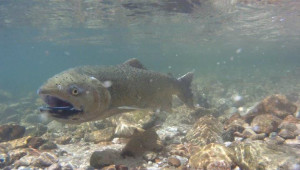
By Courtney Flatt, Northwest Public Radio
The future is looking bright for fall chinook salmon in the Columbia and Snake rivers. Predictions are in that this could be another record-breaking year for the fish.
Officials are predicting the largest return on record since 1938. That’s 1.6 million Columbia River fall chinook. Nearly 1 million of those fish will come from salmon near Hanford Reach. These are known as upriver brights, said Stuart Ellis, fisheries biologist with the Columbia River Intertribal Fish Commission.
“One interesting thing about the forecasts is that even though most of the forecasts are big, it is just the two large bright upriver stocks, the upriver brights and The pool upriver brights that we are predicting to be record high runs this year,” Ellis said.
Last year saw a record number of fall chinook salmon returning to the Columbia and Snake rivers since the dams were built. The upriver bright salmon are predicted to reach the same record as the entire returning fall chinook last year.
Joseph Bogaard, executive director of the advocacy group Save Our Wild Salmon, said the strong numbers are due in part to favorable ocean conditions, enough water spilling over dams during migration season and good habitat at Hanford Reach. That’s one of the longest free-flowing areas on the Columbia River.
Columbia River Indian tribes contend hatcheries also play a part in large Snake River fall chinook returns.
Sara Thompson, spokeswoman for the Columbia River Inter-Tribal Fish Commission said, right now, a record number of salmon are spawning in the Snake River.
“This is the highest number of salmon spawning in the Snake River Basin that we’ve seen since the Lower Granite Dam was constructed,” she said. The dam, one of four on the lower Snake River in southeast Washington, was completed in 1975.
Thompson said more wild fall chinook salmon are expected to return to the Snake River this year.
Bogaard said even though the fall chinook predictions are high, work still needs to be done to protect other endangered salmon runs.
“While the fall chinook run looks like that they’re as strong as they’ve been in quite a few years, we’ve still got a lot of work to do to protect and restore many other runs that provide the benefits to people and ecosystems in the parts of the basin,” Bogaard said.
